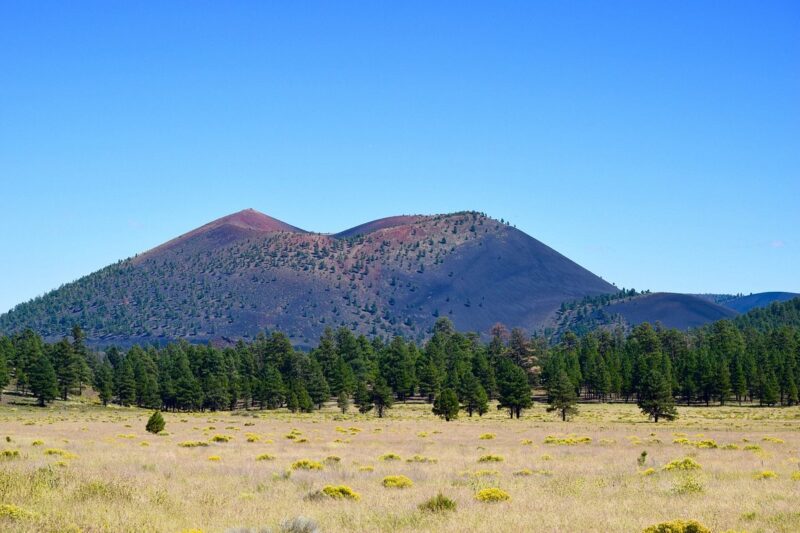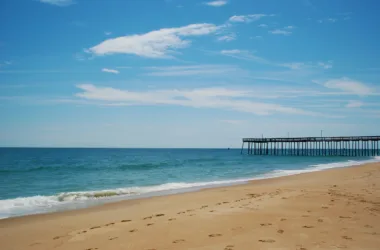Sunset Crater Volcano National Monument: Arizona is known for its iconic red rock formations and stunning desert landscapes, and one of the most unique natural wonders in the state is Sunset Crater Volcano National Monument. Located just outside of Flagstaff, this national park preserves the remains of an ancient volcano that erupted over 900 years ago. The eruption left behind a dramatic landscape of cinder cones, lava flows, and other volcanic features that attract visitors from around the world. In this article, we’ll take a closer look at Sunset Crater Volcano National Monument, including its history, geology, and cultural significance.
History of Sunset Crater Volcano National Monument
The history of Sunset Crater Volcano National Monument dates back over 900 years to a time when the area was inhabited by the Sinagua people. The Sinagua were an indigenous group that lived in northern Arizona from around 500 AD to 1425 AD. They were skilled farmers and craftspeople who built impressive cliff dwellings and other structures that still stand today.
The eruption of the Sunset Crater occurred sometime around 1085 AD and lasted for several years. The eruption was one of the most significant volcanic events in the region’s history, and it had a profound impact on the local environment and the Sinagua people. The eruption covered over 800 square miles of land with lava and ash, forcing Sinagua to abandon their homes and migrate to other areas.
Despite the destructive nature of the eruption, it also created new opportunities for Sinagua. The ash and lava from the eruption enriched the soil, making it more fertile for farming. Sinagua adapted to the new landscape by building new settlements and adjusting their farming practices. They also developed new ways of working with volcanic rock, using it to create tools, weapons, and other objects.
In the centuries that followed, the Sinagua people continued to live in the area, although they gradually moved away from the immediate vicinity of Sunset Crater. By the time Europeans arrived in the region in the 16th century, the Sinagua were no longer present in the area, but their legacy lives on in the ruins of their buildings and artifacts.
Geology of Sunset Crater Volcano National Monument
Sunset Crater Volcano National Monument is a unique geological wonder that showcases the power of volcanic activity. The park covers an area of approximately 3,000 acres and includes a variety of volcanic features, including cinder cones, lava flows, and ash fields.
The centerpiece of the park is Sunset Crater, a cinder cone that rises 1,000 feet above the surrounding landscape. The cone was formed during the eruption and is composed of layers of cinders, ash, and lava. Today, visitors can hike to the top of the cone and enjoy panoramic views of the surrounding area.
Another notable feature of the park is the lava flow known as Bonito Lava Flow. This massive flow covers over 1,200 acres and is estimated to have been created during the same eruption as Sunset Crater. The flow is composed of basalt, a type of volcanic rock that is rich in iron and magnesium. Visitors can hike along the edge of the flow and see the jagged, black rocks up close.
In addition to Sunset Crater and the Bonito Lava Flow, the park also contains other volcanic features such as ash fields, spatter cones, and lava tubes. These features provide a glimpse into the complex processes that occur during a volcanic eruption and are a testament to the power of nature.
Cultural Significance of Sunset Crater Volcano National Monument
In addition to its geological significance, Sunset Crater Volcano National Monument is also an important cultural site that reflects the history and heritage of the indigenous people who lived in the area. The Sinagua people left behind a rich legacy of art, architecture, and other cultural artifacts that are still visible in the park today.
One of the most striking examples of Sinagua architecture is the Wupatki National Monument, which is located just north of Sunset Crater. This site contains the ruins of several large Pueblo-style structures that were built by the Sinagua people in the 12th and 13th centuries. These structures include multi-story buildings that were constructed using a combination of volcanic rock, sandstone, and clay.
The Wupatki National Monument is also home to several rock art sites that contain petroglyphs and pictographs created by Sinagua and other indigenous groups. These images depict a variety of subjects, including animals, people, and abstract designs. They provide a window into the spiritual and cultural beliefs of the people who lived in the area.
Another important cultural site in the park is the Lomaki Pueblo, which is located near the base of Sunset Crater. This pueblo is believed to have been built by the Sinagua people in the late 12th century and is one of the best-preserved examples of Sinagua architecture in the region. The pueblo contains several rooms and kivas, or ceremonial spaces, that were used for various purposes by the Sinagua.
Visiting Sunset Crater Volcano National Monument
If you’re interested in visiting Sunset Crater Volcano National Monument, there are several things you should know before you go. The park is open year-round, although some areas may be closed during the winter months due to snow and ice. The best time to visit is in the spring and fall when the weather is mild and the park is less crowded.
One of the best ways to experience the park is by hiking. There are several trails that lead through the park, ranging from easy strolls to challenging hikes. The trails offer stunning views of the volcanic landscape and provide opportunities to see wildlife such as elk, deer, and coyotes.
If you’re interested in learning more about the park’s history and geology, there are several ranger-led programs that are available throughout the year. These programs include guided hikes, talks, and demonstrations that provide insights into the natural and cultural history of the park.
Conclusion
Sunset Crater Volcano National Monument is a fascinating destination that offers a unique blend of geology, history, and culture. The park is a testament to the power of nature and the resilience of the indigenous people who lived in the area. Whether you’re interested in hiking, history, or just enjoying the natural beauty of the region, Sunset Crater Volcano National Monument is definitely worth a visit. So why not plan your trip today and discover the wonders of this amazing national park for yourself?
Similar Articles









